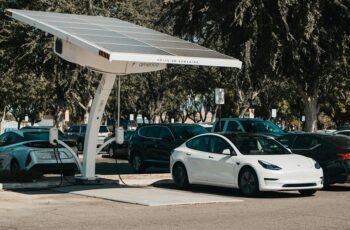Choosing the right charge current for LiFePO4 isn’t guesswork—you’ll base it on C-rate, battery size, and your goals for lifespan vs. turnaround time. You’ll typically aim for 0.2C–0.5C for everyday use, with brief higher currents only when the BMS and temperature allow. But current limits shift with temperature, wiring, and charger settings, and that’s where mistakes happen. If you want consistent performance without sacrificing cycle life, here’s what you should watch next.
Understanding C-Rate and Capacity Sizing
Although “C-rate” sounds technical, it’s simply the charge or discharge current expressed relative to a battery’s capacity. If you have a 100 Ah LiFePO4 pack, 1C equals 100 A, 0.5C equals 50 A, and so on. You use C-rate to size wiring, fusing, and busbars, and to estimate thermal load.
Understand the C rate impact on performance: higher C raises voltage sag and heat, while lower C improves efficiency and longevity. Capacity implications follow directly—if your loads demand 100 A but you want a gentle 0.3C, you’ll size capacity near 330 Ah. Conversely, if weight or space limits capacity, you must limit current to keep C reasonable. Match inverter surge and continuous loads to a C-rate your cells, BMS, and cabling can safely sustain.
Recommended Charge Currents by Battery Capacity
You’ll anchor charge current choices to C-rate so you’re always scaling to the battery’s actual capacity. From there, set capacity-based current ranges that match your pack size and charger limits. You’ll then fine-tune within that range to balance quick turnarounds with the cycle life you want.
C-Rate Fundamentals
Two core ideas make C-rate simple: it’s a measure of charge (or discharge) current relative to battery capacity, and it scales linearly. If a LiFePO4 cell is 100 Ah, 1C equals 100 A; 0.5C equals 50 A; 0.2C equals 20 A. You can do quick C rate calculations by dividing current by capacity (A ÷ Ah). That ratio tells you how hard you’re pushing the battery.
Understand C rate effects: higher C raises heat, voltage sag, and stress, while lower C improves efficiency and longevity but charges slower. Most LiFePO4 cells accept a wide range, yet you should match C-rate to the manufacturer’s specs and thermal limits. Use temperature, voltage behavior, and BMS data to confirm the chosen C-rate remains safe and repeatable.
Capacity-Based Current Ranges
Because charge current scales with capacity, it’s practical to express recommended currents as ranges tied to a battery’s Ah rating. You can translate C-rate into amps quickly: multiply the battery’s Ah by your chosen C. For most LiFePO4 packs, 0.2C–0.5C balances speed and charging efficiency, while 1C is typically the safe upper bound if the manufacturer allows it. Aim for current optimization by matching your charger’s output to the bank’s total Ah.
- 10 Ah: 2–5 A (0.2C–0.5C), up to 10 A max (1C)
- 50 Ah: 10–25 A, up to 50 A max
- 100 Ah: 20–50 A, up to 100 A max
| Feeling | Current Range |
|---|---|
| Confident | 0.2C |
| Energized | 0.5C |
| Ambitious | 1C |
Check spec sheets; prioritize thermal headroom and consistent results.
Balancing Performance and Lifespan
While faster charging tempts, set current with lifespan in mind. Match charge current to capacity using C‑rates: 0.2C–0.5C balances speed, battery longevity, and charge efficiency. For a 100 Ah LiFePO4, that’s 20–50 A. Use the low end when you prioritize cycle life, high end when uptime matters and temperatures are controlled.
Consider duty cycle. Daily cycling? Prefer 0.2C–0.3C. Occasional use with tight schedules? 0.4C–0.5C is acceptable. Monitor temperature; warm packs degrade faster, so reduce current if cells exceed recommended ranges. Verify your BMS limits and charger accuracy to prevent overcurrent.
Finish with a proper absorption/termination strategy: stop at 14.2–14.4 V (4S) and taper to 0.05C–0.1C before cutoff. This keeps internal resistance low, improves charge efficiency, and preserves usable capacity over time.
Bulk, Absorption, and Float Stages for LiFePO4
You’ll set the bulk stage to push current efficiently until the pack nears its target voltage. Next, you’ll hold a tight absorption voltage limit to top off without stressing the cells. Finally, you’ll decide whether to use float at all—and if you do, you’ll set a conservative value to avoid overcharging.
Bulk Stage Parameters
Bulk stage parameters set the pace for safely and efficiently filling a LiFePO4 battery. In this stage, you push constant current until voltage rises to the change threshold. Choose a charge rate that respects cell specs and BMS limits—commonly 0.5C for daily use and up to 1C when faster turnaround is essential. These bulk charging techniques keep temperatures low, reduce stress, and protect cycle life.
Set current based on the smallest-rated component: cell datasheet, BMS, wiring, and charger. Verify charger accuracy and current stability; err on the conservative side in hot environments. As part of best charging practices, monitor pack temperature and voltage symmetry across cells. Confirm cables are sized for the chosen current, and minimize voltage drop to avoid premature tapering.
Absorption Voltage Limits
Set the absorption voltage high enough to complete the charge, but low enough to protect LiFePO4 cells from stress. Target 14.0–14.4 V for a 12.8 V pack (3.50–3.60 V per cell). This range reliably reaches full without pushing cells into unnecessary high-voltage dwell. Above 14.4 V, heat and imbalance rise; below ~14.0 V, you’ll leave capacity on the table.
Use time or current taper to end absorption. Stop when charge current falls to 2–5% of capacity (0.02–0.05C) or after 10–30 minutes once taper begins, whichever comes first. This preserves cycle life while maintaining charge efficiency. Verify with your BMS limits and calibrate for temperature and wiring drop. If you parallel packs, match absorption voltage and termination criteria across banks.
Float Usage Guidance
While lead‑acid habits linger, float charging plays a different role with LiFePO4. You’ll still use Bulk and Absorption to reach full, but you shouldn’t park the pack at a high float. After Absorption tapers, let the charger stop or hold a very low standby voltage rather than traditional float. Many LiFePO4 makers recommend no float at all; if required for system uptime, set float around 13.4–13.6 V (4S) with minimal current.
Prioritize battery maintenance by charging to about 95–100%, then resting near 50–80% when stored. Use Bulk to the recommended current limit, Absorption just long enough for taper, then terminate. Enable BMS protections and temperature compensation off. For idle solar systems, use float charging only to offset self‑consumption, not to keep 100% SOC.
Temperature Effects and Cold-Weather Charging Limits
Even when your system looks healthy, temperature quietly dictates how a LiFePO4 battery charges, delivers power, and ages. You’re dealing with temperature sensitivity: internal resistance rises as it gets colder, so the same current creates more voltage rise and heat. In cold weather, reduce charge current and extend absorption time to reach full without stress. Below freezing, avoid charging unless you can pre-warm the cells; lithium plating can permanently reduce capacity.
1) Set temperature-compensated current limits: taper to roughly 0.2–0.3C near 0°C, and pause charging below −5°C unless heated.
2) Precondition packs: use enclosure insulation or gentle heating to bring cells to 5–10°C before accepting normal current.
3) Monitor cell temperature directly: adjust charger behavior immediately when ambient swings.
BMS Constraints: Current, Voltage, and Protection Triggers
Cold-temperature limits only matter if your protection system enforces them, and that’s the BMS’s job. Your BMS polices current, voltage thresholds, and cell balance so you don’t over-stress LiFePO4 cells. Set charge and discharge current limits that match the pack’s spec; if you exceed them, the BMS will throttle or open the circuit. Over-voltage, under-voltage, and temperature sensors trigger protective cutoffs, preserving cycle life and safety.
| Constraint | What your BMS does |
|---|---|
| Charge current | Enforces max amps; trips on sustained overcurrent |
| Discharge current | Blocks surges; uses short/long delay profiles |
| Voltage thresholds | Cuts charge near HVC; blocks load at LVC |
| Temperature | Inhibits charge below/above safe range |
| Cell balance | Bleeds high cells to align pack |
Verify trip points, delays, and recovery logic; mismatches create nuisance shutdowns or risk.
Charger Selection and Settings for Optimal Performance
Because your BMS enforces limits but doesn’t enhance charging, pick a charger that matches your pack’s LiFePO4 chemistry, voltage, and current budget. Prioritize charger compatibility with your battery chemistry and BMS specs, then dial in effective settings for constant-current/constant-voltage profiles. Look for solid voltage regulation to hit the correct absorption setpoint and protect cycle life. Favor smart chargers that log data, auto-detect faults, and meet safety standards. Size current for charging efficiency while keeping heat management under control, especially in confined enclosures. Establish maintenance practices: periodically verify calibration, connectors, and thermals.
1) Specify: pack voltage, max charge current, absorption/float choices, and temperature limits.
2) Validate: certification marks, protections, and firmware update support.
3) Monitor: temperature, taper behavior, and termination accuracy to confirm performance.
Fast Charging vs. Longevity: Finding the Balance
While speed matters, you’ll protect LiFePO4 health by capping charge rates and voltage to what the cells can tolerate over thousands of cycles. If you chase fast charging, set realistic limits: a 0.5C charge is a sweet spot for battery health, with 0.2–0.3C preferred when you prioritize longevity. Keep voltage at the manufacturer’s recommended absorption level and avoid prolonged topping at maximum charge.
Use temperature-aware charging; reduce current in heat and pause below freezing unless your cells support low‑temp charging. Stop at 90–95% state of charge when you don’t need full capacity, and avoid deep depletion before you plug in. Calibrate your expectations: faster isn’t free. By tuning charge current to your duty cycle, you’ll cut downtime without sacrificing cycle life.
Parallel and Series Banks: Current Distribution and Wiring
You’ve tuned charge rates for longevity; now make sure your pack wiring shares that load fairly. In parallel connections, use equal-length, equal-gauge leads and a true star bus to keep current distribution even. In series configurations, route identical path resistance and avoid diagonal takeoffs that skew load distribution. Size cables for peak amps, not averages, and keep lugs tight to minimize voltage drop.
1) Apply wiring techniques:
- Star or midpoint takeoffs prevent hogging.
- Fused leads at each branch improve safety considerations.
2) Prioritize bank balancing:
- Match cell age and capacity.
- Keep interconnects short and symmetrical.
3) Optimize capacity management:
- Split large banks into smaller, mirrored blocks.
- Use appropriately rated busbars.
Document torque specs, label polarities, and isolate service loops. Good wiring underpins reliable charging and longer life.
Monitoring, Safety Practices, and Maintenance Tips
Even with well-tuned charge profiles and tidy wiring, you still need vigilant monitoring and disciplined maintenance to keep LiFePO4 packs safe and healthy. Use battery monitoring that logs cell voltage, pack current, temperature, and state of charge; set alarms for over/under-voltage, over-temp, and abnormal current. Verify the BMS trips at its limits and confirm charge sources respect those thresholds.
Apply clear safety protocols: fuse each string, size cables for peak current, secure terminations, and isolate faults with breakers. Keep chargers, inverters, and solar controllers updated and calibrated.
Adopt practical maintenance tips: inspect terminals for torque and corrosion, clean vents, and review performance tracking weekly to spot drift in internal resistance or capacity. Balance cells periodically. Store around 50% SOC, cool and dry, and avoid long idling at 100% SOC.
Conclusion
You’ve got the tools to charge LiFePO4 right: match current to capacity, respect BMS limits, and tune your charger for gentle bulk and brief absorption. Keep temps in check, dial back in the cold, and prioritize 0.2C–0.5C for everyday health. Scale wiring and settings for series/parallel banks, and monitor like a pilot. When you need speed, use it sparingly. Treat your battery with care, and it’ll repay you like a faithful dog waiting at the door.

